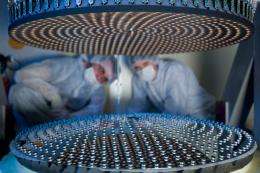Sharper than Hubble: Large Binocular Telescope achieves major breakthrough

(PhysOrg.com) -- The next generation of adaptive optics has arrived at the Large Binocular Telescope (LBT) in Arizona, providing astronomers with a new level of image sharpness never before seen. Developed in a collaboration between Italy’s Arcetri Observatory of the Istituto Nazionale di Astrofisica (INAF) and the University of Arizona’s Steward Observatory, this technology represents a remarkable step forward for astronomy.
The LBT, with its two 8.4 metre -mirrors, is the largest single optical telescope in the world. The telescope is a collaboration between institutions from the USA, Italy and Germany. Germany’s 25% participation is represented by the Max-Planck Society, the Astrophysical Institute Potsdam and Heidelberg University. The test camera for the images shown here was developed by INAF and the Max-Planck-Institute for Astronomy (MPIA) in Heidelberg.
Until relatively recently, ground-based telescopes had to live with wavefront distortion caused by the Earth’s atmosphere which significantly blurred images of distant objects (this is why stars appear to twinkle to the human eye). While there have been advancements in adaptive optics technology to correct atmospheric blurring, the LBT’s innovative system truly takes this concept to a whole new level.
In closed-dome tests beginning May 12 and sky tests every night since May 25, astronomer Simone Esposito and his INAF team tested the new device, achieving exceptional results. The LBT’s adaptive optics system, called the First Light Adaptive Optics system (FLAO), immediately outperformed all other comparable systems, delivering an image quality greater than three times sharper than the Hubble Space Telescope using just one of the LBT’s two 8.4 metre mirrors. As soon as the adaptive optics are in place for both mirrors and their light is combined appropriately, it is expected that the LBT will achieve image sharpness ten times that of the Hubble.
"This is an incredibly exciting time as this new adaptive optics system allows us to achieve our potential as the world’s most powerful optical telescope," said Richard Green, director of the LBT. "The successful results show that the next generation of astronomy has arrived, while providing a glimpse of the awesome potential the LBT will be capable of for years to come."
The unit of measure for perfection of image quality is known as the Strehl ratio, with a ratio of 100 % equivalent to an absolutely perfect image. Without adaptive optics, the ratio for ground-based telescopes is less than 1 percent. The adaptive optics systems on other major telescopes today improve image quality up to about 30 percent to 50 percent in the near-infrared wavelengths where the testing was conducted.
.jpeg)
In the initial testing phase, the LBT’s adaptive optics system has been able to achieve unprecedented Strehl Ratios of 60 to 80 percent, a nearly two-thirds improvement in image sharpness over other existing systems. The results exceeded all expectations and were so precise that the testing team had difficulty believing their findings. However, testing has continued since the system was first put on the sky on May 25, the LBT’s adaptive optics have functioned flawlessly and have achieved peak Strehl ratios of 82 to 84 percent.
"The results on the first night were so extraordinary that we thought it might be a fluke, but every night since then the adaptive optics have continued to exceed all expectations. These results were achieved using only one of LBT’s mirrors. Imagine the potential when we have adaptive optics on both of LBT’s giant eyes." said Simone Esposito, leader of the INAF testing team.
Development of the LBT’s adaptive optics system took more than a decade through an international collaboration. INAF, in particular the Arcetri Observatory, conceived the LBT instrument design and developed the electro-mechanical system, while the University of Arizona Mirror Lab created the optical elements, and the Italian companies Microgate and ADS International engineered several components. A prototype system was previously installed on the Multiple Mirror Telescope (MMT) at Mt. Hopkins, Arizona. The MMT system uses roughly half the number of actuators as the LBT’s final version, but demonstrated the viability of the design. The LBT’s infrared test camera, which produced the accompanying images, was a joint development of INAF, Bologna and the MPIA, Heidelberg.
"This has been a tremendous success for INAF and all of the partners in the LBT," said Piero Salinari, Research Director at the Arcetri Observatory, INAF. "After more than a decade and with so much care and effort having gone into this project, it is really rewarding to see it succeed so astoundingly."
This outstanding success was achieved through the combination of several innovative technologies. The first is the secondary mirror, which was designed from the start to be a main component of the LBT rather than an additional element as on other telescopes. The concave secondary mirror is 0.91 metres in diameter (3 feet) and only 1.6 millimetres thick. The mirror is so thin and pliable that it can easily be manipulated by actuators pushing on 672 tiny magnets glued to the back of the mirror, a configuration which offers far greater flexibility and accuracy than previous systems on other telescopes. An innovative "pyramid" sensor detects atmospheric distortions and manipulates the mirror in real time to cancel out the blurring, allowing the telescope to literally see as clearly as if there were no atmosphere. Incredibly, the mirror is capable of making adjustments every one thousandth of a second, with accuracy to better than ten nanometres (a nanometre is one millionth the size of a millimetre).
Provided by Max-Planck-Gesellschaft











.jpeg)





